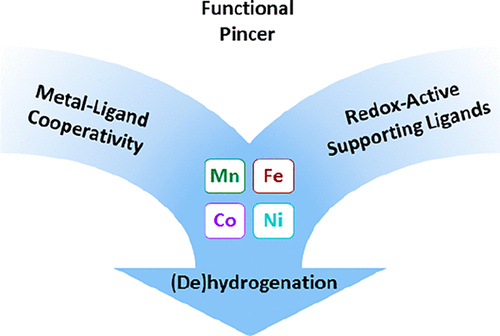当前位置:
X-MOL 学术
›
Chem. Rev.
›
论文详情
Our official English website, www.x-mol.net, welcomes your feedback! (Note: you will need to create a separate account there.)
First-Row Transition Metal (De)Hydrogenation Catalysis Based On Functional Pincer Ligands
Chemical Reviews ( IF 62.1 ) Pub Date : 2018-12-31 00:00:00 , DOI: 10.1021/acs.chemrev.8b00555 Lukas Alig 1 , Maximilian Fritz 1 , Sven Schneider 1
Chemical Reviews ( IF 62.1 ) Pub Date : 2018-12-31 00:00:00 , DOI: 10.1021/acs.chemrev.8b00555 Lukas Alig 1 , Maximilian Fritz 1 , Sven Schneider 1
Affiliation

|
The use of 3d metals in de/hydrogenation catalysis has emerged as a competitive field with respect to “traditional” precious metal catalyzed transformations. The introduction of functional pincer ligands that can store protons and/or electrons as expressed by metal–ligand cooperativity and ligand redox-activity strongly stimulated this development as a conceptual starting point for rational catalyst design. This review aims at providing a comprehensive picture of the utilization of functional pincer ligands in first-row transition metal hydrogenation and dehydrogenation catalysis and related synthetic concepts relying on these such as the hydrogen borrowing methodology. Particular emphasis is put on the implementation and relevance of cooperating and redox-active pincer ligands within the mechanistic scenarios.
中文翻译:

基于功能性钳型配体的第一行过渡金属(De)加氢催化
相对于“传统”贵金属催化的转化,在脱氢/氢化催化中使用3d金属已成为一个竞争领域。可以存储质子和/或电子的功能性钳形配体的引入,如金属-配体的协同性和配体的氧化还原活性所表达的那样,强烈刺激了这种发展,成为合理催化剂设计的概念性起点。这篇综述旨在提供功能性钳夹配体在第一行过渡金属加氢和脱氢催化中的应用以及基于这些的相关合成概念(例如氢借用方法)的全面情况。在机制方案中,特别强调了协同作用和氧化还原活性钳式配体的实施和相关性。
更新日期:2018-12-31
中文翻译:

基于功能性钳型配体的第一行过渡金属(De)加氢催化
相对于“传统”贵金属催化的转化,在脱氢/氢化催化中使用3d金属已成为一个竞争领域。可以存储质子和/或电子的功能性钳形配体的引入,如金属-配体的协同性和配体的氧化还原活性所表达的那样,强烈刺激了这种发展,成为合理催化剂设计的概念性起点。这篇综述旨在提供功能性钳夹配体在第一行过渡金属加氢和脱氢催化中的应用以及基于这些的相关合成概念(例如氢借用方法)的全面情况。在机制方案中,特别强调了协同作用和氧化还原活性钳式配体的实施和相关性。


























 京公网安备 11010802027423号
京公网安备 11010802027423号